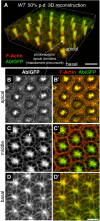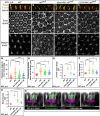Inter-plane feedback coordinates cell morphogenesis and maintains 3D tissue organization in the Drosophila pupal retina
- PMID: 38533736
- PMCID: PMC11006395
- DOI: 10.1242/dev.201757
Inter-plane feedback coordinates cell morphogenesis and maintains 3D tissue organization in the Drosophila pupal retina
Abstract
How complex organs coordinate cellular morphogenetic events to achieve three-dimensional (3D) form is a central question in development. The question is uniquely tractable in the late Drosophila pupal retina, where cells maintain stereotyped contacts as they elaborate the specialized cytoskeletal structures that pattern the apical, basal and longitudinal planes of the epithelium. In this study, we combined cell type-specific genetic manipulation of the cytoskeletal regulator Abelson (Abl) with 3D imaging to explore how the distinct cellular morphogenetic programs of photoreceptors and interommatidial pigment cells (IOPCs) organize tissue pattern to support retinal integrity. Our experiments show that photoreceptor and IOPC terminal differentiation is unexpectedly interdependent, connected by an intercellular feedback mechanism that coordinates and promotes morphogenetic change across orthogonal tissue planes to ensure correct 3D retinal pattern. We propose that genetic regulation of specialized cellular differentiation programs combined with inter-plane mechanical feedback confers spatial coordination to achieve robust 3D tissue morphogenesis.
Keywords: Drosophila eye development; 3D cytoskeletal network; Abelson; Actin cytoskeleton; Apical–basal polarity; Cell–cell interactions; Epithelial patterning; Feedback mechanism; Morphogenesis; Photoreceptor; Pigment cell.
© 2024. Published by The Company of Biologists Ltd.
Conflict of interest statement
Competing interests The authors declare no competing or financial interests.
Figures







Update of
-
Orthogonal coupling of a 3D cytoskeletal scaffold coordinates cell morphogenesis and maintains tissue organization in the Drosophila pupal retina.bioRxiv [Preprint]. 2023 Mar 7:2023.03.06.531386. doi: 10.1101/2023.03.06.531386. bioRxiv. 2023. Update in: Development. 2024 Mar 15;151(6):dev201757. doi: 10.1242/dev.201757. PMID: 36945525 Free PMC article. Updated. Preprint.
Similar articles
-
Orthogonal coupling of a 3D cytoskeletal scaffold coordinates cell morphogenesis and maintains tissue organization in the Drosophila pupal retina.bioRxiv [Preprint]. 2023 Mar 7:2023.03.06.531386. doi: 10.1101/2023.03.06.531386. bioRxiv. 2023. Update in: Development. 2024 Mar 15;151(6):dev201757. doi: 10.1242/dev.201757. PMID: 36945525 Free PMC article. Updated. Preprint.
-
Abelson tyrosine kinase is required for Drosophila photoreceptor morphogenesis and retinal epithelial patterning.Dev Dyn. 2011 Jul;240(7):1745-55. doi: 10.1002/dvdy.22674. Dev Dyn. 2011. PMID: 21674685 Free PMC article.
-
JNK is antagonized to ensure the correct number of interommatidial cells pattern the Drosophila retina.Dev Biol. 2018 Jan 1;433(1):94-107. doi: 10.1016/j.ydbio.2017.11.002. Epub 2017 Nov 11. Dev Biol. 2018. PMID: 29133184 Free PMC article.
-
Hexagonal patterning of the Drosophila eye.Dev Biol. 2021 Oct;478:173-182. doi: 10.1016/j.ydbio.2021.07.004. Epub 2021 Jul 8. Dev Biol. 2021. PMID: 34245727 Free PMC article. Review.
-
The repertoire of epithelial morphogenesis on display: Progressive elaboration of Drosophila egg structure.Mech Dev. 2017 Dec;148:18-39. doi: 10.1016/j.mod.2017.04.002. Epub 2017 Apr 19. Mech Dev. 2017. PMID: 28433748 Review.
Cited by
-
The Abelson kinase and the Nedd4 family E3 ligases co-regulate Notch trafficking to limit signaling.J Cell Biol. 2025 Jun 2;224(6):e202407066. doi: 10.1083/jcb.202407066. Epub 2025 Apr 4. J Cell Biol. 2025. PMID: 40183942
References
MeSH terms
Substances
Grants and funding
LinkOut - more resources
Full Text Sources
Molecular Biology Databases
Miscellaneous

